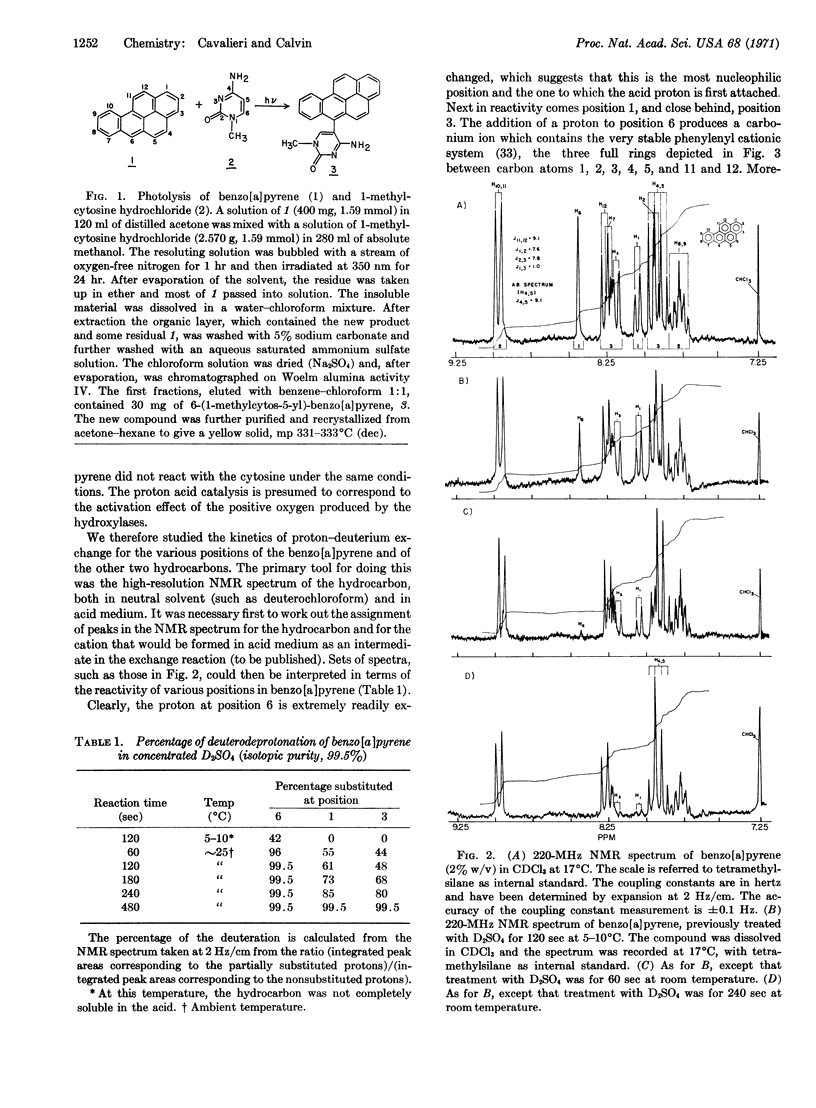Abstract
The chemical reactivity and presumably the carcinogenic activity induced in aromatic hydrocarbons by hydroxylating enzymes may be due to the generation of electrophilic centers in some (benzo[a]pyrene) or nucleophilic centers in others (7,12-dimethylbenz[a]anthracene or 3-methylcholanthrene). These centers, which are at positions complementary to the points of activation by acid-derived protons (models of the positive oxygen of the hydroxylating enzymes), may react simultaneously with corresponding cellular components.
Keywords: benzpyrene, dimethylbenzanthracene, 3-methylcholanthrene, nucleic acids
Full text
PDF


Selected References
These references are in PubMed. This may not be the complete list of references from this article.
- BOYLAND E., SIMS P. METABOLISM OF POLYCYCLIC COMPOUNDS. THE METABOLISM OF 7,12-DIMETHYLBENZ(ALPHA)ANTHRACENE BY RAT-LIVER HOMOGENATES. Biochem J. 1965 Jun;95:780–787. doi: 10.1042/bj0950780. [DOI] [PMC free article] [PubMed] [Google Scholar]
- BROOKES P., LAWLEY P. D. EVIDENCE FOR THE BINDING OF POLYNUCLEAR AROMATIC HYDROCARBONS TO THE NUCLEIC ACIDS OF MOUSE SKIN: RELATION BETWEEN CARCINOGENIC POWER OF HYDROCARBONS AND THEIR BINDING TO DEOXYRIBONUCLEIC ACID. Nature. 1964 May 23;202:781–784. doi: 10.1038/202781a0. [DOI] [PubMed] [Google Scholar]
- Berezney R., Funk L. K., Crane F. L. Nuclear electron transport. I. Electron transport enzymes in bovine liver nuclei and nuclear membrane. Biochem Biophys Res Commun. 1970 Jan 6;38(1):93–98. doi: 10.1016/0006-291x(70)91088-0. [DOI] [PubMed] [Google Scholar]
- Brookes P., Heidelberger C. Isolation and degradation of DNA from cells treated with tritium-labeled 7,12-dimethylbenz(a)anthracene: studies on the nature of the binding of this carcinogen to DNA. Cancer Res. 1969 Jan;29(1):157–165. [PubMed] [Google Scholar]
- Freeman A. E., Price P. J., Bryan R. J., Gordon R. J., Gilden R. V., Kelloff G. J., Huebner R. J. Transformation of rat and hamster embryo cells by extracts of city smog. Proc Natl Acad Sci U S A. 1971 Feb;68(2):445–449. doi: 10.1073/pnas.68.2.445. [DOI] [PMC free article] [PubMed] [Google Scholar]
- Fried J., Schumm D. E. One electron transfer oxidation of 7,12-dimethylbenz[a]anthracene, a model for the metabolic activation of carcinogenic hydrocarbons. J Am Chem Soc. 1967 Oct 11;89(21):5508–5509. doi: 10.1021/ja00997a069. [DOI] [PubMed] [Google Scholar]
- Gelboin H. V. A microsome-dependent binding of benzo[a]pyrene to DNA. Cancer Res. 1969 Jun;29(6):1272–1276. [PubMed] [Google Scholar]
- Grover P. L., Sims P. Enzyme-catalysed reactions of polycyclic hydrocarbons with deoxyribonucleic acid and protein in vitro. Biochem J. 1968 Nov;110(1):159–160. doi: 10.1042/bj1100159. [DOI] [PMC free article] [PubMed] [Google Scholar]
- Guroff G., Daly J. W., Jerina D. M., Renson J., Witkop B., Udenfriend S. Hydroxylation-induced migration: the NIH shift. Recent experiments reveal an unexpected and general result of enzymatic hydroxylation of aromatic compounds. Science. 1967 Sep 29;157(3796):1524–1530. doi: 10.1126/science.157.3796.1524. [DOI] [PubMed] [Google Scholar]
- HARPER K. H. The polycyclic hydrocarbons: metabolism, cellular binding and carcinogenesis. Br J Cancer. 1959 Dec;13:732–745. doi: 10.1038/bjc.1959.82. [DOI] [PMC free article] [PubMed] [Google Scholar]
- HEIDELBERGER C., MOLDENHAUER M. G. The interaction of carcinogenic hydrocarbons with tissue constituents. IV. A quantitative study of the binding to skin proteins of several C14-labeled hydrocarbons. Cancer Res. 1956 Jun;16(5):442–449. [PubMed] [Google Scholar]
- Heidelberger C. Studies on the cellular and molecular mechanisms of hydrocarbon carcinogenesis. Eur J Cancer. 1970 Jun;6(3):161–172. doi: 10.1016/0014-2964(70)90017-4. [DOI] [PubMed] [Google Scholar]
- Huebner R. J., Todaro G. J. Oncogenes of RNA tumor viruses as determinants of cancer. Proc Natl Acad Sci U S A. 1969 Nov;64(3):1087–1094. doi: 10.1073/pnas.64.3.1087. [DOI] [PMC free article] [PubMed] [Google Scholar]
- MILLER E. C. Studies on the formation of protein-bound derivatives of 3,4-benzpyrene in the epidermal fraction of mouse skin. Cancer Res. 1951 Feb;11(2):100–108. [PubMed] [Google Scholar]
- PULLMAN A., PULLMAN B. Electronic structure and carcinogenic activity of aromatic molecules; new developments. Adv Cancer Res. 1955;3:117–169. doi: 10.1016/s0065-230x(08)60919-7. [DOI] [PubMed] [Google Scholar]
- REES K. R., ROWLAND G. F. The metabolism of isolated rat-liver nuclei. Biochem J. 1961 Jan;78:89–95. doi: 10.1042/bj0780089. [DOI] [PMC free article] [PubMed] [Google Scholar]
- Sims P. The metabolism of 3-methylcholanthrene and some related compounds by rat-liver homogenates. Biochem J. 1966 Jan;98(1):215–228. doi: 10.1042/bj0980215. [DOI] [PMC free article] [PubMed] [Google Scholar]
- Sims P. The metabolism of 7- and 12-methylbenz[a]anthracene and their derivatives. Biochem J. 1967 Nov;105(2):591–598. doi: 10.1042/bj1050591. [DOI] [PMC free article] [PubMed] [Google Scholar]
- Sims P. The metabolism of benzo[a]pyrene by rat-liver homogenates. Biochem Pharmacol. 1967 Apr;16(4):613–618. doi: 10.1016/0006-2952(67)90071-8. [DOI] [PubMed] [Google Scholar]
- Sims P. The metabolism of some aromatic hydrocarbons by mouse embryo cell cultures. Biochem Pharmacol. 1970 Jan;19(1):285–297. doi: 10.1016/0006-2952(70)90348-5. [DOI] [PubMed] [Google Scholar]


